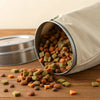Can You Mix Dry and Raw Dog Food? Understanding the Benefits and Best Practices
- Houndsy
Table of Contents
- Introduction
- The Benefits of Mixing Dry and Raw Dog Food
- Debunking Myths About Mixing Dry and Raw Dog Food
- How to Transition Your Dog to a Mixed Diet
- Ideal Ratios for Mixing Dry and Raw Dog Food
- Conclusion
Introduction
Imagine this: it’s dinnertime, and your dog is eagerly waiting by the kitchen, tail wagging in anticipation. As devoted pet parents, we strive to provide the best nutrition for our furry companions, but the sheer variety of dog food options can be overwhelming. With more pet owners considering both dry kibble and raw dog food for their beloved pets, a common question emerges: can you mix dry and raw dog food?
Recent studies show that over 70% of dog owners are exploring alternative diets for their pets, and this trend is driven by a desire for healthier, more nutritious options. Mixing dry and raw dog food can be a cost-effective solution that adds variety to your pet’s meals while enhancing their overall health. In this blog post, we’ll dive into the intricacies of feeding your dog a mixed diet, the benefits it can offer, and how to do it safely. By the end, you will have a clear understanding of how to optimize your dog's feeding routine for their health and happiness.
We will explore the myths surrounding mixed feeding, the benefits of incorporating both dry and raw food, how to transition your dog to this diet, and the ideal ratios to ensure balanced nutrition. Let’s embark on this journey together and discover how we can enrich our pets' lives with thoughtful feeding practices.
The Benefits of Mixing Dry and Raw Dog Food
Understanding the Nutritional Profiles
Before we delve into the benefits, it’s essential to understand the nutritional differences between dry kibble and raw dog food.
- Dry Dog Food (Kibble): Typically, kibble is processed and contains a mix of carbohydrates, proteins, and fats, alongside various vitamins and minerals. Most kibble has a long shelf life and is convenient for pet owners. However, many brands include fillers that may not offer optimal nutrition.
- Raw Dog Food: Raw diets often consist of muscle meat, organ meat, bones, and some vegetables. This diet is high in protein and moisture, promoting better hydration and digestion. Many proponents of raw feeding argue that this diet mirrors what dogs would eat in the wild, potentially providing more natural nutrition.
By combining both types of food, we can leverage the strengths of each. For instance, raw food can provide essential nutrients and enzymes that may be lost during the cooking process of kibble, while kibble offers convenience and stability.
Enhanced Variety and Palatability
One of the most significant advantages of mixing dry and raw food is the variety it brings to your dog’s meals. Just like us, dogs can get bored with their food. A mixed diet allows for different textures and flavors, making mealtime more exciting.
Imagine topping your dog’s kibble with a spoonful of raw meat or mixing in some chopped vegetables. This not only enhances the taste but can also improve your dog’s appetite, especially if they are finicky eaters.
Improved Digestion and Nutritional Absorption
Another benefit of mixing dry and raw dog food is the potential for improved digestion. Dogs have a remarkably adaptable digestive system, capable of processing various food types. When introducing raw food into a dog’s diet, it’s crucial to do so gradually to avoid any digestive upset.
By starting with a small amount of raw food mixed with kibble, we allow your dog’s gut bacteria to adjust. As their body becomes accustomed to the new diet, they may experience better digestion, leading to increased nutrient absorption and overall health.
Cost-Effectiveness
Feeding a 100% raw diet can be expensive and may not be feasible for every pet owner. Mixing dry and raw food can be a practical solution to this challenge. For instance, using kibble as a base and adding raw food as a topper allows us to stretch our pet food budget while still providing high-quality nutrition.
Potential Health Benefits
Research indicates that incorporating raw food into a dog’s diet can lead to several health benefits, including:
- Improved skin and coat health: The high-quality fats and proteins found in raw food can lead to shinier coats and healthier skin.
- Stronger immune system: A varied diet can help support a robust immune system, reducing the likelihood of illness.
- Reduced allergies: Mixing foods can help identify allergens or sensitivities, allowing us to adjust accordingly.
- Better dental health: Chewing raw meaty bones can promote dental hygiene by reducing plaque buildup.
Debunking Myths About Mixing Dry and Raw Dog Food
As with any topic related to pet nutrition, various myths can cloud our understanding. Let’s clear up some common misconceptions about mixing dry and raw dog food.
Myth 1: Mixing Raw and Kibble Causes Digestive Issues
One prevalent belief is that mixing raw food and kibble can lead to digestive problems. However, studies show that a dog’s digestive system is equipped to handle different food types simultaneously. The key is to ensure that any transition to a mixed diet is gradual.
Myth 2: Dogs Can’t Digest Different Foods Together
Another myth is that dogs cannot digest foods that have different digestion rates. The reality is that a dog’s digestive enzymes are versatile and can break down various types of food. Dogs have evolved as scavengers, and their bodies are designed to handle a variety of food sources.
Myth 3: Mixing Food Will Lead to Bad Bacteria Growth
Concerns about mixing raw and kibble often stem from fears of bad bacteria proliferation. While it’s true that raw food can harbor bacteria, a healthy dog's immune system is typically capable of managing this risk. Proper food handling and hygiene practices are essential to mitigate potential issues.
How to Transition Your Dog to a Mixed Diet
Transitioning your dog to a mixed diet of dry and raw food requires a careful approach to ensure a smooth adjustment. Here are some steps to guide you:
Step 1: Start Gradually
Introduce raw food slowly into your dog’s diet, beginning with small amounts mixed in with their regular kibble. A good rule of thumb is to start with about 10% raw food and 90% kibble.
Step 2: Monitor Your Dog’s Reaction
Observe how your dog responds to the new food. Look for any signs of digestive upset, such as vomiting or diarrhea. If your dog seems to tolerate the mix well, gradually increase the proportion of raw food over the course of several days.
Step 3: Adjust Based on Preferences and Needs
Every dog is different. Some may thrive on a 50/50 ratio of raw and kibble, while others may do better with a different balance. Adjust the ratio based on your dog’s preferences, dietary needs, and any recommendations from your veterinarian.
Step 4: Consider Timing
You can also choose to feed raw food and kibble at different times of the day. For example, offer kibble in the morning when you’re pressed for time and raw food in the evening when you can dedicate more time to meal preparation.
Ideal Ratios for Mixing Dry and Raw Dog Food
Finding the right ratio of dry to raw food is crucial to ensure balanced nutrition. Here are some common ratios to consider:
- 70% Kibble / 30% Raw: This ratio is suitable for dogs transitioning from a kibble-only diet to a mixed diet. It provides a safety net of familiar food while introducing new elements.
- 50% Kibble / 50% Raw: Ideal for dogs that can handle both food types equally, this ratio provides a good balance of nutrients from both sources.
- 30% Kibble / 70% Raw: For dogs that have been feeding on kibble for a while and can handle more raw food, this ratio maximizes the benefits of a raw diet.
Always consult with your veterinarian to determine the best diet and ratio for your dog’s specific needs, considering factors like age, weight, activity level, and health condition.
Conclusion
In conclusion, mixing dry and raw dog food can be a beneficial practice for many pet owners looking to enhance their dog’s diet. By understanding the nutritional profiles, debunking myths, and following a gradual transition process, we can provide our furry friends with a varied and balanced diet that meets their needs.
As responsible pet owners, it’s our duty to educate ourselves about the best feeding practices. We encourage you to reflect on your dog’s current diet and consider how a mixed feeding approach could improve their overall health and happiness.
For those looking to streamline their dog feeding routine, we recommend checking out the Houndsy Kibble Dispenser. With its innovative design and functionality, the Houndsy Kibble Dispenser will elevate your pet feeding experience, making it more convenient and enjoyable. Explore the Houndsy Kibble Dispenser today! Order Now.
FAQ
Can you mix dry and raw dog food safely?
Yes, it is generally safe to mix dry and raw dog food. Dogs have a versatile digestive system that can handle different food types. However, it’s essential to introduce new foods gradually.
What are the benefits of mixing dry and raw dog food?
Mixing dry and raw food can provide enhanced nutrition, improved digestion, variety in meals, and cost-effectiveness.
How should I transition my dog to a mixed diet?
Start by introducing small amounts of raw food with their regular kibble, monitor their reaction, and gradually increase the raw food proportion over several days.
What is the ideal ratio for mixing dry and raw dog food?
The ideal ratio can vary based on individual dogs, but common ratios include 70% kibble to 30% raw or 50% kibble to 50% raw.
Are there any myths about mixing dry and raw dog food?
Yes, common myths include the belief that mixing leads to digestive issues or that dogs cannot digest different food types together. These myths have been debunked through understanding canine digestion.
By taking the time to understand your dog’s nutritional needs and exploring mixed feeding, we can contribute to their health and happiness for years to come.












